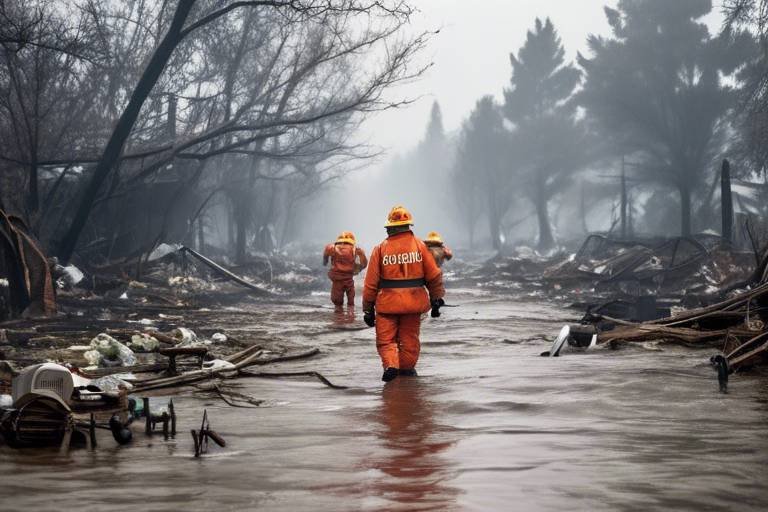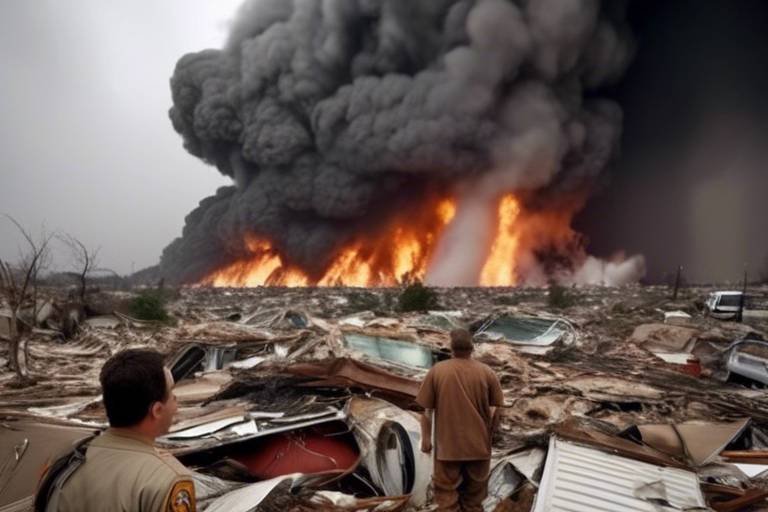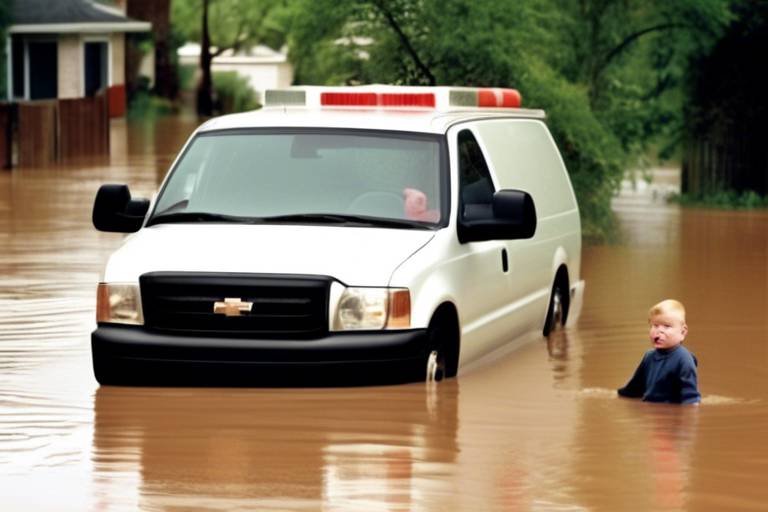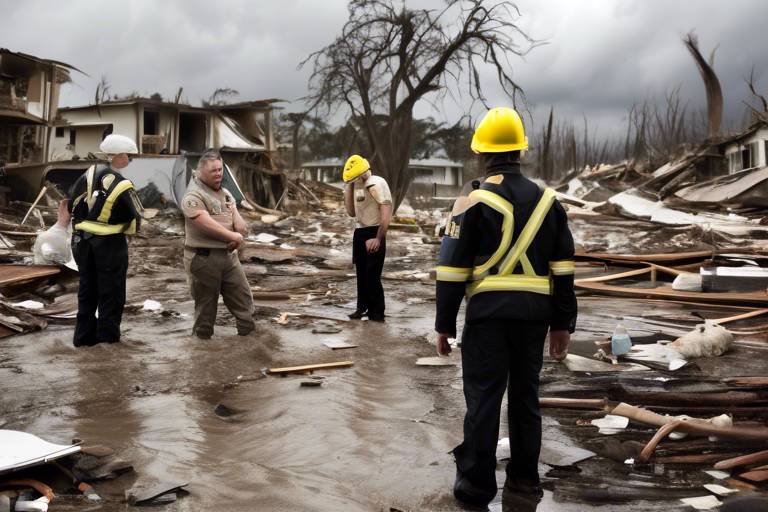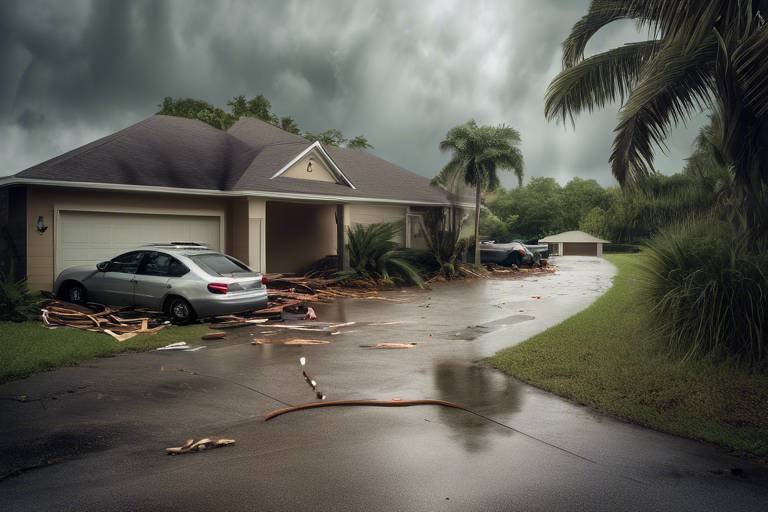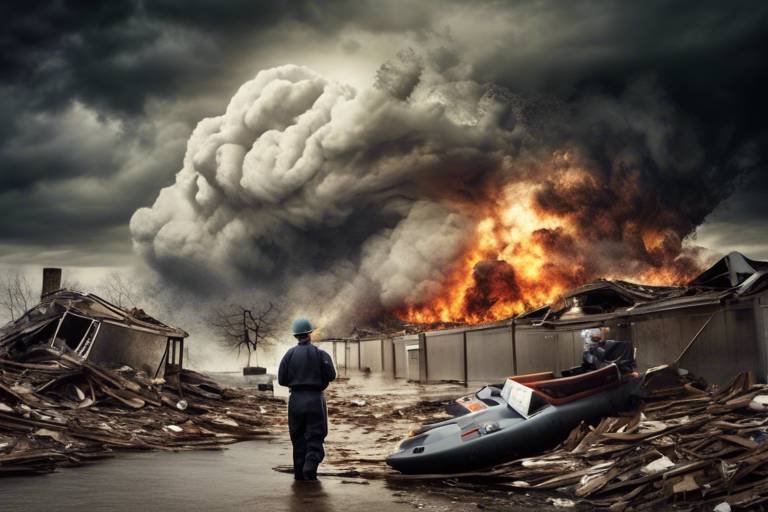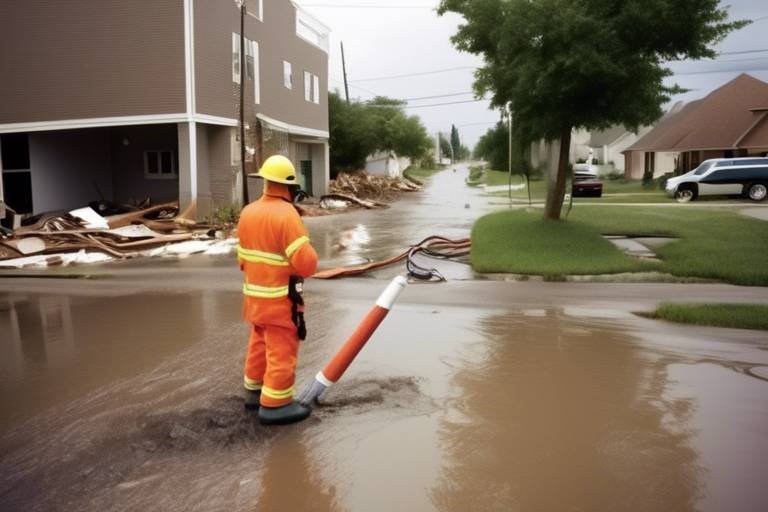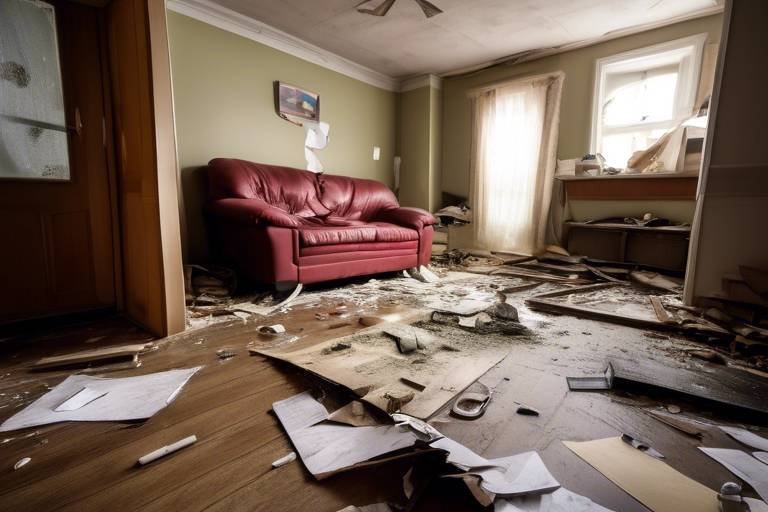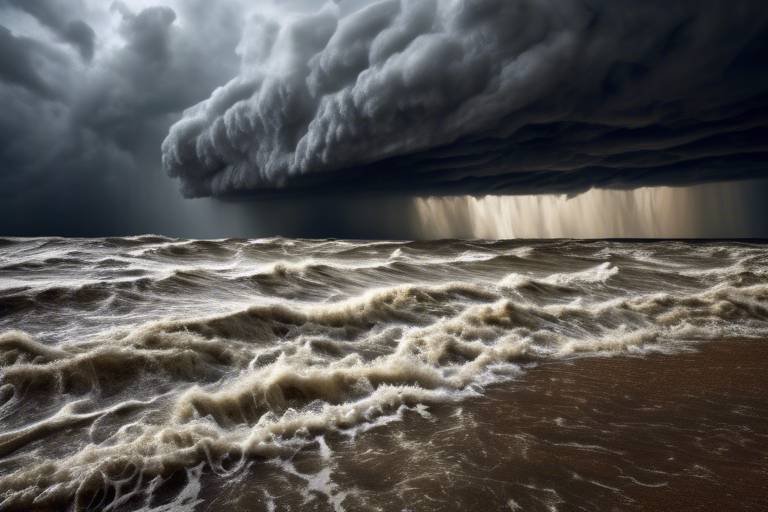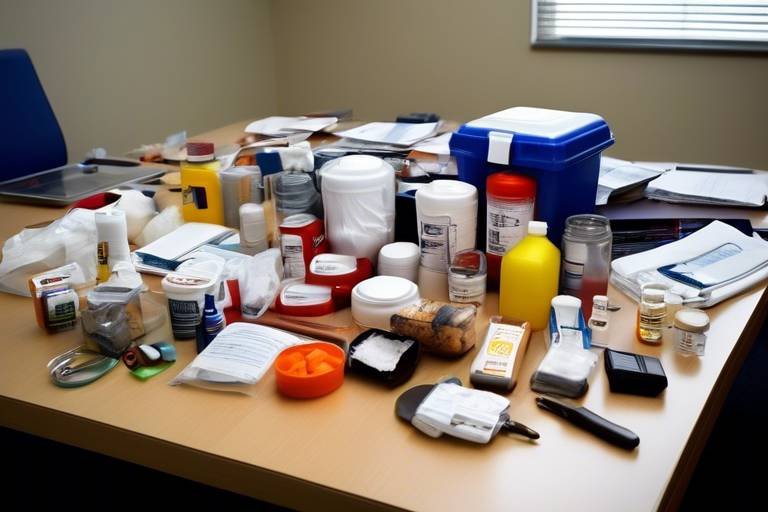What to Do When Caught in a Wildfire?
Wildfires can strike unexpectedly, turning serene landscapes into raging infernos in a matter of moments. If you ever find yourself caught in a wildfire, it's crucial to remain calm and act swiftly. Your safety is paramount, and knowing what to do can make all the difference. Imagine being in a movie, where the hero must navigate through flames and smoke—this is your reality, and you need a game plan!
First things first, if you receive warnings about a wildfire in your area, take them seriously. The moment you smell smoke or see flames, it's time to spring into action. Don't wait for the authorities to tell you what to do; your instincts are your best guide. But how do you know what to do? Here are some essential steps to follow:
- Stay Informed: Keep an eye on local news and emergency alerts. Use your smartphone or radio to stay up-to-date on the wildfire's status. Knowledge is your best ally in a crisis.
- Evacuate Early: If evacuation orders are issued, don't hesitate. Grab your emergency kit and leave immediately. The earlier you evacuate, the safer you'll be.
- Follow Evacuation Routes: Use designated evacuation routes to avoid getting trapped. These routes are planned with safety in mind, so stick to them.
As you prepare to leave, remember to take your emergency supplies. These should include essentials like water, medications, important documents, and any necessary personal items. Think of your emergency kit as your lifeline; it’s your ticket to safety. If time allows, pack a few personal belongings that hold sentimental value, but never sacrifice your safety for material items.
When evacuating, keep your vehicle's windows rolled up and the air conditioning on recirculate. This will help protect you from smoke inhalation. If you encounter flames or heavy smoke, remain calm. Drive slowly and avoid areas where the fire is active. If you find yourself in a situation where you cannot escape the fire, look for a body of water or a cleared area to take refuge. Lying flat in a ditch or depression can also provide some protection from the heat.
Once you reach safety, don’t forget to check in with family and friends to let them know you’re okay. Communication is vital during a crisis, and it can help alleviate the fears of your loved ones who may be worried about your well-being.
After the wildfire has passed, it’s essential to stay informed about the conditions in your area. Even if the fire seems to be out, there may be areas still smoldering that could flare up again. Keep an eye on local news and heed any warnings or advice from emergency services.
In summary, being caught in a wildfire is a terrifying experience, but knowing how to respond can save your life. Stay informed, evacuate early, and prioritize your safety above all else. Just like a seasoned adventurer navigating treacherous terrain, your preparedness and quick thinking can lead you safely through the flames.
Q: What should I do if I see a wildfire approaching?
A: If you see a wildfire approaching, evacuate immediately. Follow local evacuation routes and stay informed through local news and emergency alerts.
Q: How can I prepare my home for a wildfire?
A: Create a defensible space around your home, maintain your property, and have an emergency kit ready. Consider using fire-resistant plants in your landscaping.
Q: What items should I include in my emergency kit?
A: Your emergency kit should include water, non-perishable food, medications, important documents, a flashlight, batteries, and a first-aid kit.
Q: Is it safe to return home after a wildfire?
A: Only return home when authorities declare it safe. Check for hazards and be cautious of potential flare-ups in the area.

Understanding Wildfires
Wildfires are a natural phenomenon that can turn into devastating catastrophes, affecting both the environment and human life. These fires occur when dry vegetation ignites, fueled by various factors such as heat, wind, and low humidity. Understanding the nature of wildfires is crucial for anyone living in or near fire-prone areas. They can start from natural causes like lightning strikes, but human activities such as campfires, discarded cigarettes, and arson are also significant contributors. The speed at which a wildfire spreads can be astonishing, often doubling in size within minutes under the right conditions.
The conditions that lead to rapid wildfire spread include:
- Dry Weather: Prolonged periods of drought can dry out vegetation, making it more susceptible to ignition.
- High Temperatures: Elevated temperatures can increase the likelihood of fire ignition and spread.
- Strong Winds: Winds can carry embers to new locations, igniting additional fires far from the original source.
- Fuel Availability: Dense vegetation provides ample fuel for wildfires, allowing them to grow quickly and uncontrollably.
In addition to these factors, human behavior plays a significant role in wildfire occurrences. For instance, during dry seasons, people may engage in outdoor activities that can inadvertently spark a fire. Therefore, understanding the local environment and adhering to safety regulations is essential. Wildfires not only threaten homes and lives but also have long-term ecological impacts, such as soil degradation and loss of wildlife habitat.
Moreover, wildfires can be categorized into different types based on their origin and behavior. For example:
| Type of Wildfire | Description |
|---|---|
| Ground Fire | Burns underground in the root zone, often smoldering for long periods. |
| Surface Fire | Burns along the forest floor, consuming low-lying vegetation. |
| Crown Fire | Burns through the tops of trees, often spreading rapidly in strong winds. |
By grasping the dynamics of wildfires, individuals can better prepare themselves and their properties. Knowledge is power, and understanding the causes and effects of wildfires can be the difference between safety and disaster. So, whether you live in a rural area or a suburban neighborhood, being aware of wildfire risks and behaviors is essential for your safety and peace of mind.

Preparation Before a Wildfire
When it comes to wildfires, **preparation is your best defense**. Just like you wouldn’t venture into a storm without an umbrella, you shouldn’t wait until the flames are licking at your doorstep to think about safety. Preparing for a wildfire involves a mix of foresight, practical action, and a bit of creativity. So, what steps can you take to ensure you're ready? Let’s dive into the essentials.
First off, creating a **defensible space** around your home is crucial. This space acts as a buffer between your property and the wildfires that may threaten it. Think of it as a protective moat around your castle. A defensible space typically extends at least 30 feet from your home, but this can vary depending on the vegetation and slope of your land. To establish this space, you’ll want to focus on landscaping techniques that reduce fire risk. For instance, removing dead plants, trimming trees, and using gravel instead of mulch can significantly lower the chances of a fire spreading to your home.
So, how do you go about creating this defensible space? Here are some key landscaping techniques to consider:
- Clear the Area: Remove any dead leaves, branches, and debris that can catch fire easily.
- Trim Trees: Make sure tree branches are at least 10 feet away from your roof and other structures.
- Use Fire-Resistant Materials: Opt for non-flammable materials for decks and fences to reduce fire risk.
Now, let’s talk about your garden. Did you know that the types of plants you choose can either help or hinder your fire safety? Selecting fire-resistant plants can make a significant difference in your home’s ability to withstand a wildfire. Some excellent options include:
- Lavender
- Yarrow
- Succulents
- Rockrose
These plants are not only beautiful but also have a higher moisture content, making them less likely to ignite. So, when you’re planning your garden, think of it as an investment in your safety. Just like a good insurance policy, it pays off in the long run.
Regular maintenance is another key factor in wildfire preparation. It’s like going to the gym; you don’t just go once and expect to be fit forever! Consistent upkeep is essential. Make it a habit to check your property every few months. Clear away any debris, trim back overgrown vegetation, and ensure that your gutters are clean. This not only helps in fire prevention but also keeps your home looking sharp. Remember, a well-maintained property is less appealing to wildfires, just like a tidy home is less appealing to pests!
Finally, let’s not forget about having an emergency kit ready. This kit is your safety net, your lifeline in case the worst happens. Think of it as your survival backpack for the unexpected. Essential items to include are:
- Water and non-perishable food
- A flashlight with extra batteries
- A first aid kit
- Important documents (in a waterproof container)
By gathering these supplies ahead of time, you can ensure that you’re not scrambling for essentials when every second counts. It’s like having a fire extinguisher; you hope you never need it, but you’re glad it’s there if you do.

Creating a Defensible Space
When it comes to protecting your home from the devastating effects of wildfires, creating a defensible space is one of the most crucial steps you can take. Think of this space as a protective barrier that can help slow down or even stop the spread of fire towards your property. By strategically managing the area around your home, you can significantly reduce the risk of flames reaching your doorstep. But how do you go about creating this safe zone?
First and foremost, it’s important to understand that defensible space is not just about clearing away all vegetation. Instead, it involves a thoughtful approach to landscaping and maintenance that balances safety with aesthetics. Ideally, you want to create a buffer zone that extends at least 30 feet from your home. This area should be free of flammable materials, and you can achieve this by:
- Regularly mowing your lawn and keeping it well-watered.
- Removing dead plants, leaves, and branches that could serve as fuel.
- Trimming trees and shrubs to create vertical and horizontal separation between plants.
In addition to these practices, consider the placement of your plants. For instance, you want to avoid clustering flammable vegetation close to your home. Instead, space out your plants and use hardscaping features like gravel or stone pathways to create breaks that can help slow the fire's advance. This is where the concept of zoning comes into play. You can divide your defensible space into three zones:
| Zone | Description | Recommended Actions |
|---|---|---|
| Zone 1 (0-5 feet) | Immediate area around the home | Use non-flammable materials, remove all flammable items, and keep this area clear. |
| Zone 2 (5-30 feet) | Surrounding landscape | Maintain low-growing plants, regularly prune trees, and create firebreaks. |
| Zone 3 (30+ feet) | Outer edge of your property | Thin out dense vegetation, create space between trees, and use fire-resistant plants. |
Another vital aspect of creating a defensible space is selecting the right plants. Choosing fire-resistant plants can make a significant difference in your landscape's resilience against wildfires. These plants are less likely to ignite and can help slow down fire spread. Some excellent choices include:
- Lavender
- Succulents
- Yarrow
- California lilac
Moreover, maintaining your property is a continuous effort. Regularly checking for debris accumulation, especially during dry seasons, is essential. A well-maintained landscape not only looks good but also acts as your first line of defense against wildfires. Remember, your home is your sanctuary, and taking these steps to create a defensible space is a proactive way to protect it. So, roll up your sleeves and get to work—your future self will thank you!
Q: How far should I clear vegetation around my home?
A: Ideally, you should create a defensible space that extends at least 30 feet from your home.
Q: What are some fire-resistant plants I can use?
A: Consider using plants like lavender, succulents, yarrow, and California lilac, which are known for their fire-resistant properties.
Q: Is it enough to just clear the area around my home?
A: While clearing the area is important, you should also focus on maintaining your landscape and choosing the right plants to enhance fire safety.

Choosing Fire-Resistant Plants
When it comes to safeguarding your home from the threat of wildfires, one of the most effective strategies is to choose fire-resistant plants for your landscaping. These plants not only enhance the aesthetic appeal of your property but also serve as a protective barrier against flames. Imagine your garden as a fortress; the right plants can act as sentinels, standing guard against the encroaching fire.
But what exactly makes a plant fire-resistant? Generally, these plants have high moisture content, are less likely to catch fire, and can withstand heat better than others. For instance, plants with thick, waxy leaves tend to be more resilient. Additionally, choosing native plants that are adapted to your local climate can significantly improve your landscape's fire resistance. They are often more drought-tolerant and require less maintenance, which is a win-win situation!
Here are some popular fire-resistant plants that can be a great addition to your garden:
- Lavender: Known for its stunning purple flowers and soothing fragrance, lavender is not only beautiful but also highly resistant to fire.
- Yarrow: This hardy perennial can thrive in various conditions and has a high moisture content, making it less likely to ignite.
- Agave: With its thick, fleshy leaves, agave is a succulent that can withstand extreme heat.
- California Lilac: This flowering shrub is not only stunning but also resilient against flames due to its high moisture content.
Incorporating these plants into your landscaping can significantly reduce the risk of fire spreading to your home. However, it's not just about the plants themselves; the placement and spacing of these plants are equally important. Ensure that there is adequate space between them to prevent the fire from jumping from one plant to another. A good rule of thumb is to maintain a distance of at least 5 feet between plants, especially if they are more flammable.
Moreover, consider grouping fire-resistant plants together. This creates a natural barrier that can slow down the spread of fire. Think of it like building a wall of defense around your home. By strategically placing these plants, you can create a protective zone that will help to shield your property from flames.
Don't forget about maintenance! Regularly pruning and removing dead or dry foliage can help keep your fire-resistant plants healthy and effective. Just like a well-maintained car runs better, a well-kept garden will offer better protection against wildfires. Also, watering your plants consistently can help maintain their moisture content, making them even less flammable.
In conclusion, choosing the right fire-resistant plants is a crucial step in wildfire preparedness. By selecting native, moisture-rich species and maintaining them properly, you can create a stunning landscape that not only beautifies your property but also acts as a formidable defense against the devastating effects of wildfires.

Maintaining Your Property
When it comes to wildfire prevention, regular maintenance of your property can be a game-changer. Just like a gardener tends to their plants to help them thrive, homeowners must nurture their surroundings to create a safe haven against wildfires. This means taking proactive measures to ensure your home is less susceptible to the devastating effects of fire. Think of your property as a fortress; the stronger the walls, the better you can defend against an oncoming invasion.
One of the first steps in maintaining your property is to clear away debris. This includes removing fallen leaves, dead branches, and any other flammable materials that could serve as fuel for a fire. Imagine a pile of dry leaves as a matchstick waiting to be lit; even a small spark can ignite a catastrophic blaze. Aim to create a buffer zone around your home by keeping the area free of clutter. Regularly raking leaves and trimming overgrown bushes can significantly reduce fire hazards.
Another essential aspect of property maintenance is landscaping. Choosing the right plants and arranging them wisely can make a world of difference. For instance, instead of planting highly flammable species, opt for fire-resistant plants that can withstand heat and flames. You might be wondering, “What are fire-resistant plants?” Here’s a quick list of some excellent choices:
- Lavender
- Aloe Vera
- Succulents
- Yarrow
- Rockrose
Additionally, it’s crucial to maintain a defensible space around your property. This space should ideally extend at least 30 feet from your home. In this zone, consider keeping grass short, removing any dead vegetation, and spacing out trees to minimize the risk of fire spreading. Think of this area as a firebreak, a protective barrier that can slow down or even stop a wildfire from reaching your home.
Furthermore, don’t overlook your roof and gutters. These areas often accumulate debris that can ignite from embers carried by the wind. Regularly cleaning your gutters and ensuring your roof is free of leaves and branches can prevent a small issue from turning into a major disaster. It’s like maintaining a car; if you ignore the oil change, you might end up with a broken engine. So, make sure to give your home the same level of care!
Lastly, consider investing in fire-resistant building materials if you’re planning any renovations. This could include using non-combustible roofing materials or fire-resistant siding. While these upgrades might require an initial investment, they can save you a lot of heartache and money in the long run, should a wildfire threaten your area.
In summary, maintaining your property is not just about aesthetics; it’s about creating a safe environment. By regularly clearing debris, choosing fire-resistant plants, maintaining a defensible space, and considering fire-resistant materials, you can significantly lower the risk of your home being affected by wildfires. Remember, the best defense is a good offense, and being proactive in your property maintenance can make all the difference in a wildfire situation.
Q1: How often should I maintain my property to prevent wildfires?
A1: It’s best to conduct maintenance regularly, ideally every month during the dry season, to clear debris and assess the condition of your landscaping.
Q2: Are there specific plants I should avoid in wildfire-prone areas?
A2: Yes, avoid highly flammable plants like eucalyptus, pine, and certain ornamental grasses that can easily catch fire.
Q3: What is a defensible space, and how can I create one?
A3: A defensible space is an area around your home that is maintained to reduce fire risk. You can create one by clearing flammable materials, trimming trees, and ensuring a minimum distance between vegetation and structures.
Q4: How can I stay informed about wildfire risks in my area?
A4: Sign up for local alerts, follow your local fire department on social media, and check news outlets for updates on wildfire conditions.

Emergency Kits and Supplies
When it comes to wildfires, being prepared can mean the difference between safety and chaos. An emergency kit is not just a box of random items; it's a carefully curated collection of supplies that can help you navigate through the turmoil of a wildfire situation. Think of it as your personal safety net, designed to ensure you have everything you need at your fingertips. So, what should you include in your emergency kit? Let’s break it down.
Your emergency kit should be tailored to your specific needs, but there are some essential items that everyone should consider. Start with the basics: food and water. Aim for at least a three-day supply of non-perishable food items, such as energy bars, canned goods, and dried fruits. Pair this with a gallon of water per person per day. It's crucial to stay hydrated, especially when you're under stress.
Next, don't forget about your health and safety. Include a first aid kit stocked with bandages, antiseptics, and any personal medications you may need. It’s also wise to have a flashlight with extra batteries, as wildfires can lead to power outages. A battery-operated radio can keep you informed about the situation, so you stay updated even when the electricity goes out.
Another critical aspect of your kit is important documents. Make copies of your identification, insurance papers, and any other vital records, and store them in a waterproof container. This way, if you have to evacuate quickly, you won’t risk losing these essential items. Additionally, consider including a few personal items that provide comfort, such as a favorite book or a family photo. These small touches can help ease anxiety during a stressful time.
Lastly, think about your pets. If you have furry family members, include pet food, water, and their favorite toys in your emergency kit. Remember, they rely on you to keep them safe too! To help you get started, here’s a quick checklist of items to include in your emergency kit:
- Non-perishable food (3-day supply)
- Water (1 gallon per person per day)
- First aid kit
- Flashlight with extra batteries
- Battery-operated radio
- Copies of important documents (in waterproof container)
- Comfort items (book, photo)
- Pet supplies (food, water, toys)
It’s also wise to regularly check and update your emergency kit to ensure that all items are in good condition and that food is not expired. This way, when the time comes, you won’t be scrambling to gather supplies; you’ll be ready to go. Remember, preparation is key in wildfire situations, and having a well-stocked emergency kit can provide peace of mind when you need it most.
Q: How often should I check my emergency kit?
A: It's advisable to check your emergency kit at least twice a year. This ensures that food and supplies are fresh and that everything is in working order.
Q: What should I do if I have to evacuate?
A: If you need to evacuate, take your emergency kit with you, follow evacuation routes as advised by authorities, and stay informed through your radio or mobile alerts.
Q: Are there any specific items I should include for children?
A: Yes! Include snacks, toys, and any necessary medications or comfort items for children to help ease their anxiety during emergencies.

Immediate Actions During a Wildfire
When the flames roar and the smoke billows, knowing what to do can mean the difference between safety and disaster. If you find yourself caught in a wildfire, staying calm and acting swiftly is crucial. First and foremost, assess your surroundings. Are you in a safe location? If the fire is approaching, it’s time to take decisive action. Remember, wildfires can spread rapidly, often faster than you can run. This is why evacuation procedures are paramount. If authorities issue an evacuation order, do not hesitate. Gather your essentials and leave immediately, as the chaos of a wildfire can escalate in mere moments.
While evacuating, it’s vital to stay informed. Regularly check your phone or radio for updates from local authorities. They will provide critical information about the fire's path and any changes in evacuation routes. Consider this: it’s like being in a video game where the map is constantly changing. You need to adapt quickly to survive. Utilize reliable sources such as official emergency services or news outlets to get the most accurate updates. Social media can be a double-edged sword during emergencies; while it can spread information quickly, it can also spread misinformation. Stick to credible sources.
When you prepare to evacuate, ensure you have your emergency kit ready. This kit should include essentials such as water, food, medications, important documents, and a flashlight. Think of it as your survival backpack, packed with everything you need to sustain yourself in the face of uncertainty. Here’s a quick checklist of items to include in your emergency kit:
- Water (at least one gallon per person per day for at least three days)
- Non-perishable food (a three-day supply)
- Flashlight and extra batteries
- First aid kit
- Whistle (to signal for help)
- Dust mask (to help filter contaminated air)
- Moist towelettes, garbage bags, and plastic ties (for personal sanitation)
- Local maps
- Cell phone with chargers and a backup battery
Once you’re on the road, remember to stay alert. Keep your windows up and your air conditioning set to recirculate to avoid inhaling smoke. If you encounter flames or heavy smoke, turn around and find an alternate route. It’s like navigating through a maze; one wrong turn could lead you into danger. Always have a plan B, C, and even D when it comes to escape routes.
Lastly, if you find yourself trapped, don’t panic. Seek shelter in a sturdy building if possible. If you’re caught outside, find a low-lying area such as a ditch to lie down in. Cover your body with clothing or a blanket to protect against heat and smoke. Remember, the fire will pass, but your safety is the top priority. Stay low to the ground, breathe through a cloth, and wait until it’s safe to move.
In summary, immediate actions during a wildfire are about quick thinking, preparation, and staying informed. Your safety is paramount, and knowing how to respond can save your life and the lives of others. So, stay alert, act decisively, and remember that every second counts when facing the fury of a wildfire.
Q: What should I do if I see a wildfire?
A: If you see a wildfire, immediately contact local authorities or emergency services. Do not attempt to fight the fire yourself.
Q: How can I prepare my family for a wildfire?
A: Create an emergency plan that includes evacuation routes, a communication plan, and an emergency kit. Practice drills with your family to ensure everyone knows what to do.
Q: What should I include in my emergency kit?
A: Your emergency kit should include water, food, a flashlight, a first aid kit, important documents, and any medications you may need.
Q: How can I stay informed during a wildfire?
A: Stay informed by following local news, official emergency services, and weather updates. Use your phone or radio to receive real-time alerts.

Evacuation Procedures
When a wildfire is raging nearby, knowing when and how to evacuate can be the difference between safety and disaster. First and foremost, always heed the warnings from local authorities. They are your best source of information regarding the fire’s progress and the need for evacuation. If you receive an evacuation order, don’t hesitate—time is of the essence.
Before you find yourself in the thick of chaos, familiarize yourself with the evacuation routes in your area. These are often outlined in local emergency plans, and knowing them in advance can save precious minutes when every second counts. Ideally, you should have multiple routes planned in case one becomes blocked or unsafe. Think of it like having a backup plan for your backup plan!
As you prepare to evacuate, gather your emergency kit, which should include essentials like food, water, medications, and important documents. It’s crucial to stay calm and gather your family members, pets, and belongings efficiently. Remember to keep your vehicle fueled and ready to go at all times during wildfire season.
When you are ready to leave, follow these important steps:
- Drive with your headlights on to enhance visibility.
- Keep windows closed and vents shut to prevent smoke from entering your vehicle.
- Avoid driving through smoke or flames; if visibility is poor, pull over and wait until conditions improve.
Once you reach safety, stay tuned to local news and emergency services for updates. You might be tempted to return home to check on things, but doing so can put you at risk if the fire has not been fully contained. It’s essential to remain informed and patient during the aftermath.
In conclusion, evacuation procedures during a wildfire are critical for your safety. By being prepared and knowing the steps to take, you can navigate this challenging situation with greater confidence and security.
Q: What should I do if I can't evacuate in time?
A: If you find yourself unable to evacuate, find a room in your home with few windows, close all doors, and seal any gaps to prevent smoke from entering. Stay low to the ground to avoid inhaling smoke and keep your phone charged to stay updated on the situation.
Q: How can I prepare my pets for evacuation?
A: Ensure your pets are included in your emergency kit. Have a designated carrier or leash ready, and make sure their vaccinations are up to date. Familiarize them with your evacuation routes and keep a supply of food and water for them.
Q: What should I do after a wildfire?
A: After a wildfire, prioritize your safety. Assess your property for damage and stay informed about air quality. Seek support if needed, as emotional recovery is just as important as physical recovery.

Staying Informed
When a wildfire is raging nearby, staying informed is not just a good idea; it's a crucial lifeline. Imagine being in a situation where flames are licking at the edges of your property, and you have no idea how fast they're spreading or where to go. It’s like being in a suspenseful movie where every second counts! To navigate these tense moments effectively, you need to arm yourself with the right information.
First and foremost, you should have multiple sources of information readily available. Relying on just one channel can be risky. Here are some vital sources to consider:
- Local News Outlets: Television and radio stations often provide real-time updates on wildfire conditions and evacuation orders.
- Emergency Alert Systems: Sign up for alerts from your local emergency management office. These systems can send you immediate notifications via text or email.
- Social Media: Follow local fire departments and emergency services on platforms like Twitter and Facebook for live updates and community alerts.
- Mobile Apps: Download apps specifically designed for emergency alerts and weather updates. Many of these apps can provide tailored notifications based on your location.
Additionally, understanding the terminology used in wildfire reporting can empower you to respond more effectively. For instance, terms like “red flag warning” or “mandatory evacuation” carry significant weight and urgency. Knowing what these terms mean can help you decide when to act swiftly.
Moreover, keep an eye on the weather. Wildfires can change direction rapidly based on wind conditions and humidity levels. A simple weather app can keep you updated on local forecasts, allowing you to anticipate potential threats. Think of it as having a radar that helps you navigate through a stormy sea—without it, you might be sailing blind!
Lastly, don’t underestimate the power of community. Join local groups or forums where residents share information and resources. This network can be a valuable asset, providing you with insights that official channels may not cover. It’s like having a neighborhood watch that keeps everyone informed and safe.
In summary, staying informed during a wildfire is about being proactive. By diversifying your sources of information, understanding critical terminology, monitoring weather conditions, and engaging with your community, you can significantly enhance your safety and preparedness. Remember, in the face of danger, knowledge is not just power—it’s your best defense!
Q1: What should I do if I receive an evacuation order?
A1: Follow the order immediately. Ensure you have your emergency kit ready, and take your pets with you. Leave as soon as it is safe to do so, using the recommended evacuation routes.
Q2: How can I stay updated if the power goes out?
A2: Keep a battery-powered radio handy to listen for updates. Also, ensure your mobile devices are charged and consider having a portable charger available.
Q3: What information should I include in my emergency kit?
A3: Your emergency kit should include water, non-perishable food, medications, important documents, a flashlight, batteries, and a first aid kit.
Q4: How can I prepare my home for a potential wildfire?
A4: Create a defensible space around your home, use fire-resistant materials for landscaping, and regularly maintain your property to reduce fire hazards.

Post-Wildfire Recovery
Recovering from a wildfire can feel like climbing a mountain after a landslide—daunting and overwhelming. The aftermath of such an event leaves not only physical destruction but also emotional scars. It's crucial to approach recovery with a clear plan and support system. First and foremost, take a moment to breathe and acknowledge the challenges ahead. You’re not alone in this journey; many have walked this path before you.
Assessing the damage is your first step. Walk around your property, if it’s safe to do so, and take note of what has been lost or damaged. This includes your home, personal belongings, and even the landscape around you. Document everything with photos and notes; this will be invaluable for insurance claims and recovery plans. Remember, this process can be emotionally taxing, so don’t hesitate to lean on friends, family, or professional counselors for support.
Once you’ve assessed the damage, it’s time to reach out to your insurance company. Make sure to file your claim as soon as possible. Having a detailed inventory of your losses will streamline this process. Many insurance companies have specific guidelines for wildfire claims, so familiarize yourself with your policy and what it covers. If you’re unsure, consider consulting with a local attorney or a public adjuster who specializes in fire damage claims.
As you navigate through the rebuilding process, consider your long-term safety. This is a perfect opportunity to incorporate fire-resistant materials and designs into your new home. Think of it like upgrading your defense system; you want to be better prepared for any future threats. For example, using non-combustible siding, installing firebreaks, and creating a defensible space around your property can significantly reduce the risk of future wildfires.
Emotional recovery is just as important as physical rebuilding. It’s common to experience a range of emotions, from grief over lost possessions to anxiety about the future. Engaging in community support groups can be incredibly beneficial. Sharing your experience with others who have faced similar challenges can foster healing and create a sense of camaraderie. Additionally, consider professional counseling if you find yourself struggling to cope.
Lastly, don’t underestimate the power of community. Rebuilding is not just about structures; it’s about relationships and support. Participate in local recovery efforts, volunteer, or attend community meetings focused on rebuilding and safety. These connections can provide not only practical help but also emotional support, reminding you that you are part of a larger community working towards recovery.
- What should I do first after a wildfire? Start by assessing the damage and ensuring your safety. Document losses and contact your insurance provider.
- How can I emotionally recover from a wildfire? Seek support from friends, family, or professional counselors. Joining support groups can also help.
- What are some fire-resistant materials for rebuilding? Consider using non-combustible siding, metal roofs, and fire-resistant landscaping.
- How can I prevent future wildfires? Create a defensible space, maintain your property, and use fire-resistant plants in landscaping.
Frequently Asked Questions
-
What should I do to prepare for a wildfire?
Preparation is key! Start by creating a defensible space around your home. This means clearing flammable materials, maintaining your yard, and choosing fire-resistant plants. Also, assemble an emergency kit with essentials like water, food, medications, and important documents. Don't forget to have an evacuation plan ready!
-
How can I stay informed during a wildfire?
Staying updated is crucial. Use reliable sources such as local news stations, official government websites, and emergency alert systems. Social media can also provide real-time updates, but always verify the information before acting. Consider downloading apps that provide alerts for wildfire activity in your area.
-
What are the signs that I need to evacuate?
Look out for official evacuation orders, smoke, and flames approaching your area, or if you notice changes in air quality. If you feel unsafe or if local authorities advise you to leave, it’s best to evacuate immediately. Remember, your safety is the top priority!
-
What items should I include in my emergency kit?
Your emergency kit should have the basics: water (one gallon per person per day), non-perishable food, a flashlight, batteries, a first aid kit, and any necessary medications. Don’t forget important documents, cash, and a whistle to signal for help. Tailor your kit to your family’s specific needs!
-
How can I recover after a wildfire?
Recovery can be tough, but it's possible! Start by assessing the damage to your property and contacting your insurance company. Seek support for emotional recovery, as wildfires can be traumatic experiences. Rebuilding may take time, so be patient with yourself and lean on community resources for help.



